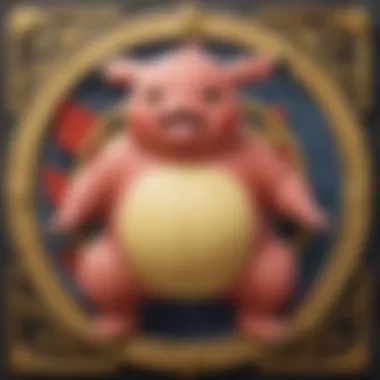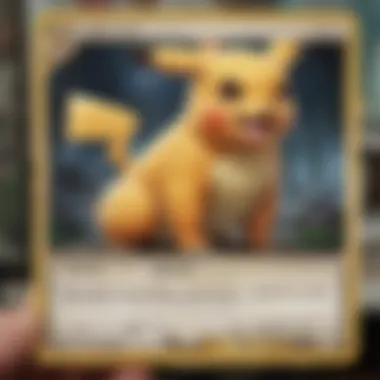Exploring the Impact of Grading Companies on Pokemon Card Values


Pokemon Game Overview
In the vast universe of Pokemon, the games have been a cornerstone of the franchise, attracting a diverse range of players from all walks of life. The history of Pokemon games dates back to the late 1990s, with the release of the original Pokemon Red and Blue versions, captivating a generation of players with its compelling gameplay and unique creatures to collect and train. Over the years, the gameplay mechanics have evolved significantly, introducing new features such as abilities, natures, and mega evolutions, adding depth and complexity to the gameplay experience.
Evolution of Gameplay Mechanics
The evolution of gameplay mechanics in the Pokemon games has been a gradual and intriguing process. From the early days of simple turn-based battles to the introduction of breeding, natures, and individual values (IVs) that impacted a Pokemon's stats, the games have continuously reinvented themselves to stay fresh and engaging for both new and returning players. The strategic depth of team building has also seen enhancements with the addition of new battle formats like Double Battles and the introduction of new typings, making each battle a test of skill and strategy.
Preface to Different Game Versions
With each new generation of Pokemon games, players are introduced to a new region to explore, new Pokemon to encounter, and fresh challenges to overcome. From the lush landscapes of Kanto to the bustling metropolis of Galar, each region offers a unique setting with its own set of gyms, Elite Four, and legendary Pokemon to discover. The different game versions, such as Sword and Shield, offer exclusive Pokemon, gym leaders, and storylines, encouraging players to trade and connect with others to complete their Pokedex.
Prelude to Card Grading in the Pokemon Industry
Card grading in the Pokemon industry holds immense significance, serving as a crucial element for collectors and investors alike. Understanding the condition of a card, its authenticity, and evaluation standards are pivotal for enthusiasts in this vibrant market. Whether it's ensuring the preservation of card quality, verifying the genuineness of a collectible, or establishing a standardized assessment process, card grading shapes the landscape of Pokemon trading.
Understanding the Importance of Card Grading
Preservation of Card Condition
Preservation of card condition stands as a cornerstone in the realm of grading. It entails safeguarding the physical integrity of cards, ensuring they retain their pristine state over time. This aspect is crucial for collectors who seek to maintain the value and appearance of their prized possessions. By focusing on preserving card condition, grading companies offer reassurance to individuals invested in the longevity and quality of their Pokemon cards.
Authentication of Card Authenticity
The authentication of card authenticity addresses a fundamental concern in the collectibles market: trust. By verifying the legitimacy of Pokemon cards, grading companies instill confidence in buyers and sellers alike. Through meticulous examination and authentication processes, these companies eliminate doubts surrounding counterfeit products, fostering a secure environment for transactions within the Pokemon community.
Standardization of Card Evaluation
Standardization in card evaluation sets clear guidelines for assessing the quality and worth of Pokemon cards. By establishing consistent criteria for grading, companies ensure fairness and accuracy in their evaluations. This uniform approach not only enhances transparency but also streamlines the valuation process, offering collectors a reliable framework for understanding the grading outcomes of their cards.
History of Card Grading in Pokemon
Emergence of Grading Services


The emergence of grading services marked a paradigm shift in the Pokemon trading landscape. With the rising demand for authenticated and professionally graded cards, grading services stepped in to fill this essential niche. Their introduction brought much-needed credibility to the market, elevating the status of Pokemon cards from mere collectibles to valuable assets with certified grades.
Evolution of Grading Standards
The evolution of grading standards reflects the dynamic nature of the Pokemon industry. Over time, grading criteria have evolved to meet the changing demands and trends of collectors and investors. This evolution signifies the adaptability and growth of grading companies in response to the evolving landscape of Pokemon card collecting, ensuring relevance and accuracy in their evaluations.
Benefits of Grading Pokemon Cards
Enhanced Market Value
Enhanced market value is a primary benefit of grading Pokemon cards. Graded cards command higher prices in the market due to their certified condition and authenticity. This increased value appeals to collectors and investors seeking valuable additions to their Pokemon card collections, offering a tangible return on investment in the long run.
Protection Against Counterfeits
Protection against counterfeits is an inherent advantage of graded Pokemon cards. By undergoing rigorous authentication processes, graded cards mitigate the risks associated with counterfeit products. This protection assures buyers of the card's authenticity, safeguarding them from potential scams or fraudulent transactions within the competitive Pokemon card market.
Increased Credibility in Transactions
Graded Pokemon cards instill increased credibility in transactions, fostering trust among buyers and sellers. With certified grades provided by reputable grading companies, individuals can engage in transactions with confidence, knowing the true value and condition of the cards involved. This enhanced credibility promotes a trustworthy environment within the Pokemon card community, encouraging secure and transparent dealings.
Criteria Used by Grading Companies
In the realm of the Pokemon industry, the criteria utilized by grading companies holds immense importance. These criteria serve as the bedrock for assessing the quality and authenticity of Pokemon cards, catering to the meticulous demands of collectors and investors. By delving into the specific elements that grading companies focus on, such as the quality of card surface, edges, corners, and overall presentation, individuals can make informed decisions regarding the value of their cards. Understanding these criteria is essential for navigating the complex landscape of the Pokemon card market, where even the minutest details can significantly impact a card's market worth.
Quality of Card Surface
Scratch-Free Surface
When it comes to the scratch-free surface of Pokemon cards, collectors and investors are concerned with maintaining the pristine condition of their valuable possessions. A scratch-free surface not only enhances the visual appeal of the card but also indicates a higher level of care and preservation by the cardholder. This particular aspect is crucial in distinguishing between cards of varying conditions, where the absence of scratches signifies top-notch quality and elevates the card's overall desirability in the market. While a scratch-free surface may seem like a minor detail, it plays a major role in upholding the value and integrity of Pokemon cards.
Centering of Card
Looking at the centering of a card unveils another layer of scrutiny employed by grading companies in the Pokemon industry. The centering of a card refers to the alignment of the card's elements, such as borders and illustrations, within the card's borders. Optimal centering is indicative of superior craftsmanship and printing precision, factors that contribute significantly to a card's aesthetic appeal and market value. Cards with perfect centering are highly sought after by collectors for their rarity and impeccable presentation, highlighting the meticulous nature of grading companies in evaluating the overall quality of Pokemon cards.
Card Edges and Corners


Sharpness of Corners
When assessing the sharpness of corners on Pokemon cards, grading companies focus on the condition of the card's edges, a crucial component in determining a card's grade. Sharp corners showcase the card's durability and protection from wear and tear, signifying a card's longevity and resilience in maintaining its structure over time. Cards with sharp corners are favored among collectors for their durability and are often perceived as higher quality, driving up their market value and desirability.
Smooth Edges
Smooth edges are another aspect scrutinized by grading companies, as they offer insights into the overall condition and handling of a Pokemon card. Cards with smooth edges suggest proper care and maintenance by previous owners, reflecting a higher standard of preservation and attention to detail. The absence of rough edges enhances a card's visual appeal and tactile experience, making it more appealing to potential buyers and commanding a premium price in the competitive Pokemon card market.
Overall Card Presentation
Print Quality
The print quality of a Pokemon card is a pivotal factor considered by grading companies, as it directly influences the card's visual appeal and aesthetic value. High print quality indicates exceptional detailing, color vibrancy, and clarity in the card's design, elevating its desirability among collectors and investors. Cards with superior print quality not only stand out among their counterparts but also symbolize superior craftsmanship and attention to detail, factors that significantly impact a card's market value and overall allure.
Alignment of Card Elements
Examining the alignment of card elements plays a crucial role in evaluating the overall presentation of Pokemon cards. A well-aligned card, where textual and graphic elements are correctly positioned within the card's borders, signifies meticulous printing and quality control measures. Cards with precise alignment exude a sense of professionalism and craftsmanship, enhancing their visual appeal and collector appeal. Grading companies prioritize the alignment of card elements as a key criterion in determining a card's grade, underscoring the significance of precision and accuracy in the assessment of Pokemon card quality.
Impact of Card Grades on Value
In the dynamic realm of Pokemon card collecting and investing, the significance of card grades on value cannot be overstated. Card grades serve as a crucial yardstick that determines the worth and desirability of a card within the market. For collectors and investors alike, understanding the impact of these grades is paramount in making informed decisions when it comes to purchasing, valuing, and trading Pokemon cards. The grading process not only adds a layer of authenticity and quality assurance but also plays a pivotal role in establishing a card's market value. By delving into the intricacies of card grades and their implications on value, individuals can navigate the Pokemon card landscape with confidence and precision.
Higher Grades, Higher Value
Price Disparities Among Grades
The concept of price disparities among different grades of Pokemon cards is a fundamental aspect that heavily influences the overall value of a card. This phenomenon refers to the variation in market prices based on the assigned grade of a card, with higher graded cards commanding significantly higher values compared to their lower graded counterparts. Price disparities among grades stem from the rarity, condition, and desirability of a particular card, with collectors and investors showing a strong preference for pristine, near-perfect specimens. Understanding these price differentials is essential for individuals looking to assess the investment potential and resale value of their Pokemon card collections. By recognizing the market trends surrounding price disparities among grades, collectors can strategically capitalize on opportunities and acquire cards that offer optimal value appreciation.
Demand for Near-Mint Cards
The demand for near-mint Pokemon cards occupies a central position within the grading industry, reflecting collectors' pursuit of cards in excellent condition. Near-mint cards, characterized by minimal wear, sharp corners, and pristine surfaces, embody the pinnacle of quality in the grading spectrum. The high demand for near-mint cards is driven by the aesthetic appeal, rarity, and investment value associated with cards that exhibit superior condition. Collectors and investors actively seek out near-mint specimens due to their potential for significant value appreciation over time. While meeting the demands for near-mint cards can be challenging, the rewards in terms of heightened market value and desirability make them a sought-after commodity in the Pokemon card market.
Investment Potential of Graded Cards


Long-Term Price Appreciation
The investment potential of graded Pokemon cards lies in their long-term price appreciation, a compelling factor that attracts collectors and investors seeking sustainable returns. Pokemon cards with a history of consistent price appreciation demonstrate their resilience as valuable assets in the collectibles market. Factors such as card rarity, historical significance, and popular demand play crucial roles in determining a card's potential for long-term price growth. By identifying cards with a track record of steady appreciation, individuals can strategically allocate their resources and build a portfolio with strong investment potential. This strategic approach enables collectors to not only derive enjoyment from their card collections but also leverage them as lucrative investment vehicles over the years.
Market Trends for Graded Cards
The evolving market trends for graded Pokemon cards provide valuable insights into the dynamic nature of the collectibles market and its impact on card values. Monitoring market trends allows collectors and investors to stay informed about shifts in demand, pricing dynamics, and emerging opportunities within the Pokemon card ecosystem. By staying attuned to market trends, individuals can adapt their collecting and investment strategies to align with prevailing market conditions, thereby maximizing their potential returns and portfolio growth. Understanding the nuances of market trends for graded cards equips enthusiasts with the knowledge needed to make informed decisions, capitalize on favorable trends, and navigate the ever-changing landscape of Pokemon card collecting and investing.
Top Grading Companies in the Pokemon Market
In the realm of the Pokemon card industry, the significance of top grading companies cannot be overstated. These companies play a pivotal role in determining the quality and authenticity of Pokemon cards, offering assurance to collectors and investors alike. By evaluating cards based on specific criteria, these grading companies help drive the market and establish trust among stakeholders. Understanding the landscape of the top grading companies is essential for anyone involved in the Pokemon card ecosystem.
Beckett Grading Services
Reputation and Recognition
Beckett Grading Services stands out in the market due to its exceptional reputation and widespread recognition. The trust and credibility associated with Beckett's name make it a preferred choice for many collectors and investors. The reliability of Beckett's grading assessments adds significant value to graded Pokemon cards and instills confidence in transactions. However, this high regard may also lead to increased demand, potentially impacting turnaround times for grading services.
Grading Process Overview
The grading process at Beckett is marked by thoroughness and precision. From inspecting the card surface for imperfections to assessing the centering and overall presentation, Beckett's methodology is comprehensive. This attention to detail ensures consistency in grading outcomes and maintains the integrity of the grading standards. While Beckett's rigorous approach contributes to the accuracy of grades, it can also result in longer wait times for card evaluations, which is a trade-off for quality assurance.
Professional Sports Authenticator (PSA)
Industry Dominance
Professional Sports Authenticator, commonly known as PSA, dominates the grading industry due to its long-standing presence and extensive reach. The widespread acceptance of PSA grades solidifies its position as a key player in the market, shaping trends and influencing prices. Collectors and investors often prioritize PSA-graded cards due to the brand's established authority and market influence. However, the high demand for PSA's services can lead to processing delays, impacting the overall efficiency of the grading process.
Grading Criteria Comparison
PSA's grading criteria are meticulously designed to assess every aspect of a Pokemon card comprehensively. From evaluating edges and corners to analyzing print quality and alignment, PSA sets high standards for card condition and presentation. The stringent criteria help maintain uniformity in grading outcomes and establish benchmarks for card quality. While PSA's strict measures contribute to the credibility of graded cards, some individuals may find the criteria challenging, leading to potential discrepancies in grading expectations.
Other Notable Grading Companies
SGC Grading
SGC Grading offers a unique perspective in the grading landscape, emphasizing certain aspects that set it apart from other companies. The specific focus on certain grading factors may appeal to collectors with distinct preferences or requirements. SGC's approach may provide an alternative option for individuals seeking grading services tailored to specific card attributes. However, the specialized nature of SGC's criteria could lead to variations in grading outcomes compared to more mainstream companies.
CGC Trading Cards
CGC Trading Cards bring a fresh outlook to the grading arena, introducing innovative features and methodologies. The incorporation of new technologies or grading techniques may attract collectors looking for modernized grading practices. CGC's forward-thinking approach could establish it as a frontrunner in the evolving grading space, appealing to tech-savvy individuals and fostering growth within the grading industry. Nonetheless, the adoption of new processes may also pose challenges in terms of acceptance and adaptation within the traditional grading community.







